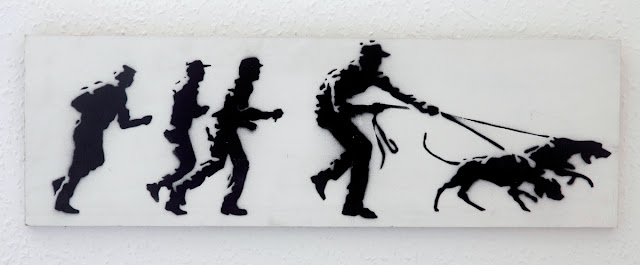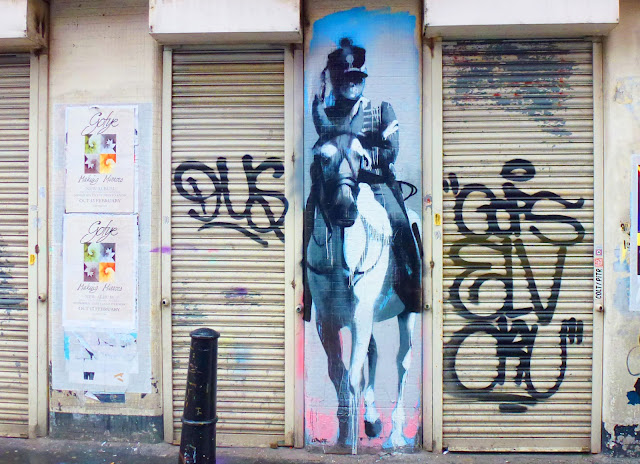Friday 12 April 2013
Eluus: The dark side
I've seen only one work by Eelus. I found this piece in Dublin, and when I posted it on instagram the artist him self asked for the photo. Eelus moved to London when he was 22 and became fascinated by the street art scene in the Shoreditch area and began to make work in the streets him self. He rapidly got a reputation for imagniative, dark and mystical stencils. Eelus in his own words: “I live in a different world to most people. A world that is crawling with hidden magic and strange creatures. There are dinosaurs and strange beasts within the centre of the Earth, Bigfoot is alive and well within the forests of many lands and the skies are full of beings from other worlds. There are gnomes in the mountains, secret bunkers in the desert, and always, ALWAYS monsters under the bed. From within this world, I love to paint, draw, photograph, write, watch, read, listen and most importantly, learn. My goal is to continue making a living from doing all these things I love and being creative in any way I can." Eelus doesn't do art in the streets anymore, but in his studio and exhibit in galleries.
Together with this post I choos "Both Sides Now" with Joni Mitchell (Click on the link or the 'play' button in the box below.
Wednesday 10 April 2013
Conor Harrington: The old and the new
Conor Harrington, originally from Cork in Ireland, combines his graffiti background with his training in fine arts. A common theme in his works are conflicts within modern masculine identity in the urban environment. He lives and work in London and have gallery exhibitions and do street art work all over the world. The picture above I took in East London. Harrington's works are not common in the streets, but when you spot one, you'll get surprised and just know it's his work. Last summer he also did work in the north of Norway. You can see more of his work and projects on conorsaysboom.
| Conor Harrington in Dublin |
Together with this piece I go for Gorillaz with 68 state. (Click on the link or the 'play' button in the box below).
Labels:
68 state,
Art,
Conor Harrington,
Culture,
Dublin,
Gatekunst,
Gorillaz,
Ireland,
Kultur,
Kunst,
London,
Street Art,
UK
Thursday 4 April 2013
Pøbel & Østrem: Brothers in Street Art
I don't know if Pøbel & Østrem are two persons or one person. Pøbel is a pseudonym for a Stavanger based street artist mainly doing stencils and Atle Østrem, a previous writer from Stavanger, is now a street artist and artist doing stencils, graffiti and gallery exhibitions. Both artists have a long history of cooperation, and in this work pøbel did the bear and Østrem did the text. I took the photo in Stavanger (south-west norway) and was made for the Nuart festival in 2010. It's a funny piece, but have a clear reference to climate change. A typical way for street art to make a commentary on a social issue.
I love Stavanger, I lived there for a couple of years, finnishing college. I have a lot of good memories from that period. I sort of started with 'blank sheets' there, got new friends, independence and never looked back. After college I moved on and lived 'here and there' untill I settled in Bergen. Nowadays, I visit Stavanger on a regular basis to teach and usually I walk around in town on my free time. Looking for some new art works in the streets.
Pøbel is doing well and have become known nationally and internationally for his work together with Dolk in the rural area of Lofoten in the north of norway. The summer of 2012, Pøbel went even further north to the small community of Vardø. An area suffering from depopulation. Pøbel organised a street art festival there with internationally known street artists: Komafest. The media response was very good and high quality street art creativity did put the small community of Vardø on the map. The mayor of the community publicly thanked Pøbel for his initiativ. After all, "Pøbel" is a norwegian word for vandal
Together with this post I choose The Specials with "A Message to You Rudy" (Click on the link or the 'play' button below to listen).
Monday 1 April 2013
Robert Clarke: Seven years with Banksy
 During the christmas holidays I read Will Ellsworth-Jones: The man behind the wall (gifted to me by my daughter). A good read, and I got insight into Banksy's work, life and development as an phenomenon in the art world. This Easter I picked up a new book from the store, written by a friend of Banksy, Seven years with Banksy by Robert Clarke. I looked forward to spending some relaxing holidays reading about the elusive Banksy. Opposite to Ellsworth-Jones, who never interviewed or met Banksy, Clarke claimed friendship to Banksy, and hanged out with him in New York, London, Glastonbury and Bristol. At least, periodically for seven years (1995 - 2002). The early years of Banksy's creative period. The cover of the book even have a picture of Banksy (from Behind).
During the christmas holidays I read Will Ellsworth-Jones: The man behind the wall (gifted to me by my daughter). A good read, and I got insight into Banksy's work, life and development as an phenomenon in the art world. This Easter I picked up a new book from the store, written by a friend of Banksy, Seven years with Banksy by Robert Clarke. I looked forward to spending some relaxing holidays reading about the elusive Banksy. Opposite to Ellsworth-Jones, who never interviewed or met Banksy, Clarke claimed friendship to Banksy, and hanged out with him in New York, London, Glastonbury and Bristol. At least, periodically for seven years (1995 - 2002). The early years of Banksy's creative period. The cover of the book even have a picture of Banksy (from Behind). |
| Banksy painting at the Glastonbury Festival in 1999. It's not Clarke's mums photo |
 |
| I was kind of disappointed when Robert Clarke did'n publish the piece he bought in 1998 for "a tenner" in his book, but it seems to be available on the net. |
Roberts girfriend Johanna plays a minor part in the book, as the girlfriend back in sweeden. Many pictures in the book is credited her, also the pictures of Paradise Quarry in Somerset. Robert tells that Robin express his liking for Johanna and how important that this is for Robert. My guess is that Johanna is more involved in the story than the book implies.
 |
| Johanna Köhlin-Clarke's picture |
The book "seven years with Banksy" doesn't give the same insight into Banksy's work or even Baksy as a person as Ellsworth-Jones' book, but give us some good stories from a person that did meet Banksy in person late 90's and beginning of 2000 on several occasions. He even participate in some of the "raids" Banksy did in London and Somerset, just hanging around with no spray can or artistic abitions him self. He's just in it for the fun and now he is making a buck on this book. Probably is this the first book of this kind from people who have "hanged out" with Banksy or known him. I'm pretty sure that Robert and Robin don't "hang out" anymore, and I'm sure that Banksy have read the book and had some laughs behind his suspicious interest when it comes to revealing who he is and his identity.
Subscribe to:
Posts (Atom)



